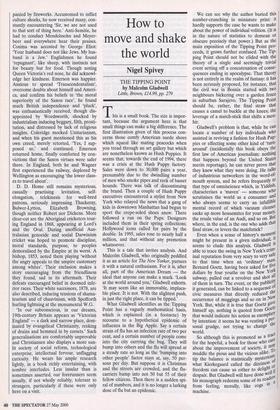How to move and shake the world
Nigel Spivey
THE TIPPING POINT by Malcolm Gladwell Little, Brown, £14.99, pp. 279 This is a small book. The size is impor- tant, because the argument here is that small things can make a big difference. The first illustration given of this process con- cerns those comfy American suede shoes which squeal like mating peacocks when you tread through an art gallery but which are nonetheless known as Hush Puppies. It seems that, towards the end of 1994, there was a crisis at the Hush Puppy factory. Sales were down to 30,000 pairs a year, presumably due to the dwindling number of men who smoke pipes and reek of basset hounds. There was talk of discontinuing the brand. Then a couple of Hush Puppy executives encountered a stylist from New York who relayed the news that a gang of kids in downtown Manhattan had begun to sport the crepe-soled shoes anew. There followed a run on the Pups. Designers included them in their spring collections; Hollywood icons called for pairs by the double. In 1995, sales rose to nearly half a million, and that without any premotion whatsoever.
This is a tale that invites analysis. And Malcolm Gladwell, who originally peddled it as an article for The New Yorker, pursues it with a natural enthusiasm. For it is, after all, part of the American Dream — the ideal that anyone can make a mark. 'Look at the world around you,' Gladwell exhorts. `It may seem like an immovable, implaca- ble place. It is not. With the slightest push, in just the right place, it can be tipped.'
What Gladwell identifies as the Tipping Point has a vaguely mathematical basis, which is explained (in a footnote) by recourse to a hypothetical epidemic of influenza in the Big Apple. Say a certain strain of flu has an infection rate of two per cent, and a certain number of people come into the city carrying the bug. They will bump into others and the flu will spread at a steady rate so long as the 'bumping into other people' factor stays at, say, 50 per- sons per day. But suppose it is Christmas and the streets are crowded, and the flu- carriers bump into not 50 but 55 of their fellow citizens. Then there is a sudden spi- ral of numbers, and it is no longer a lurking dose of flu but an epidemic. We can see why the author buried this number-crunching in miniature print: it hardly supports the case he wants to make about the power of individual volition. (It is in the nature of statistics to demean or obscure precisely that power.) But as the main exposition of the Tipping Point pro- ceeds, it grows further confused. The Tip- ping Point should not be elided with the theory of a single and seemingly trivial event setting off a concatenation of conse- quences ending in apocalypse. That theory is not entirely in the realm of fantasy: it has been seriously proposed, for instance, that the civil war in Bosnia started with two neighbours bickering over a garden fence in suburban Sarajevo. The Tipping Point should be, rather, the final straw that causes a camel to buckle at the knees; the leverage of a match-stick that shifts a men- hir.
Gladwell's problem is that, while he can locate a number of key individuals who assisted in reviving a fashion for Hush Pup- pies or effecting some other kind of 'turn- around' (incidentally this book obeys the first law of American journalism: nothing that happens beyond the United States merits reportage), he can never prove that they knew what they were doing. He talks of industrious networkers in the word-of- mouth system, and he refers frequently to that type of omniscience which, in Yiddish, characterises a 'maven' — someone wh°, scrutinises the world as a consumer and who always seems to carry an infallible mental record of which vacuum cleaner sucks up more housemites for your moneY, the resale value of an Audi, and so on. But where, in the end, is the one who adds that final straw, or levers the matchstick? Even when a sense of history's moment might be present in a given individual, it seems to elude this analysis. Gladwell is able to trace the swing in New York's crim- inal reputation from very scary to very safe to that time when an 'ordinary' Bernard Goetz, having been asked for five dollars by four youths on the New Ynt„' subway, pulled out a revolver and shot 3P of them in turn. The event, or the publicity it generated, can be linked to a sequence of civic measures that directly reduced the occurrence of muggings and so on in NeW York. But, while it is true that Goetz gave himself up, nothing is quoted from Goetz that would indicate his action as exemplary by intention: it seems he was venting a sonal grudge, not trying to change the world. So although this is promoted as a tract for the hopeful, a book for those who eatc about the improvement of society, it 111., 37_ muddle the pious and the vicious alike. '1U tip the balance is statistically mysterious; i what Kierkegaard called the dizziness °I. freedom can cause us either to delight „If despair. But Gladwell will have done we'u_ his monograph redeems some of its reader; from feeling, morally, like cogs in machine.


































































 Previous page
Previous page